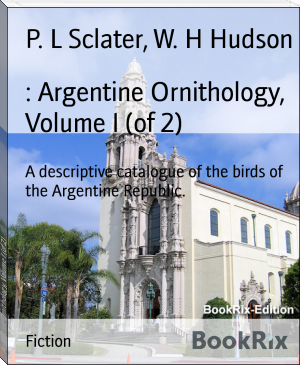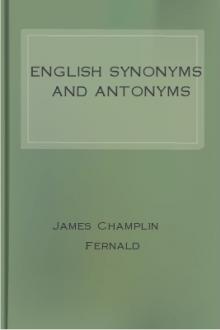: Argentine Ornithology, Volume I (of 2), P. L Sclater, W. H Hudson [best authors to read txt] 📗

- Author: P. L Sclater, W. H Hudson
Book online «: Argentine Ornithology, Volume I (of 2), P. L Sclater, W. H Hudson [best authors to read txt] 📗». Author P. L Sclater, W. H Hudson
MIMUS TRIURUS 8
CINCLUS SCHULZI 11
III. Fig. 1. CYCLORHIS OCHROCEPHALA 23
Fig. 2. CYCLORHIS ALTIROSTRIS 24
STEPHANOPHORUS LEUCOCEPHALUS 38
SALTATRICULA MULTICOLOR 61
Fig. 1. MOLOTHRUS BADIUS, ad. 95
Fig. 2. MOLOTHRUS RUFOAXILLARIS, pull. 86
VII. TÆNIOPTERA RUBETRA 120
VIII. PHYTOTOMA RUTILA, ♂ et ♀ 164
HOMORUS LOPHOTES 195
X. DRYMORNIS BRIDGESI 199
INTRODUCTION.As regards its Bird-life the Neotropical Region, which, according to the
arrangement usually adopted, consists of America south of the Isthmus of
Tehuantepec together with the West Indies[1], may be most conveniently
divided into six Subregions. These are:--
[1] _Cf._ Sclater, Journ. Linn. Soc., Zool. ii. p. 143 (1857).
The _Transpanamic Subregion_, embracing the great Central-American
Isthmus from Tehuantepec down to Panama.
The _Antillean Subregion_, containing the West-India Islands.
The _Colombian Subregion_, containing the South-American littoral and
the adjacent Andean ranges in Venezuela, Colombia, Ecuador, Peru, and
Bolivia.
The _Amazonian Subregion_, containing Guiana and the valleys of the
Orinoco and Amazons and their confluents.
The _Brazilian Subregion_, containing the great wooded and campos
districts of Southern Brazil and Paraguay.
The _Patagonian Subregion_, consisting of Antarctic America up to the
Brazilian wood-districts and the highlands of Bolivia on the eastern
side of the Andes, and apparently extending as far as the Gulf of
Guayaquil on the west.
It is, of course, impossible to draw a precise line between these six
Subregions, and any boundaries assigned to them can only be regarded as
approximative; but it is obvious that nearly, if not quite, the whole of
the Argentine Republic, the Avifauna of which we are now considering,
comes within the limits of the Patagonian Subregion. It is possible that
the birds of the Territory of Misiones and of some parts of Northern
Corrientes may be more nearly akin to those of Brazil, but we may say
generally that the Argentine Republic belongs to the Patagonian
Subregion.
As shown in the succeeding pages, the number of species of Birds as yet
ascertained to be found within the Argentine Republic[2] is about 430.
We will now take the leading groups of the Neotropical Ornis, one after
another, and consider the _rôle_ they play in the Argentine Avifauna, so
as to get some general ideas as to its peculiarities.
[2] We have not included within the scope of the present work the
territory of Santa Cruz and Tierra del Fuego, which are politically
part of the Argentine Republic, but only Northern Patagonia down to
the Rio Negro.
The subjoined Table contains in the first column the number of
Neotropical species assigned to each of the 20 different Orders of Birds
in the 'Nomenclator Avium Neotropicalium.' In the second column is given
the corresponding number of Argentine species of each order according to
the present work. The total number of Neotropical species will be seen
to be about eight times as many as those of the Argentine Avifauna;
so that where this average is exceeded in the individual orders the
particular group may be considered to be over-represented, and where it
is not reached to be under-represented in the Argentine Avifauna. This
is of course a very rough-and-ready mode of calculation, because it
assumes that every species has an equal area of distribution, which is
not ordinarily the case; but it will serve to give us some general ideas
on the subject. We will now proceed to consider the principal groups one
after another, and to point out their comparative importance in the
Argentine Avifauna.
The known Argentine Passeres, according to the present work, are 229 in
number; those of the Neotropical Region, according to the 'Nomenclator,'
are 1976; so that the species of Argentine Passeres, according to the
ratio which we have adopted, would be very little short of the average
numbers. If, however, we divide the Passeres up into the three suborders
of Oscines, Oligomyodæ, and Tracheophonæ, we shall find that the
Oligomyodæ are rather in excess of the estimated average, while the
species of the two other groups are deficient. This arises mainly from
the large number of Tyrannidæ belonging to the Argentine Ornis. Not less
than 63 species of this group have been already discovered within its
limits. Besides Tyrants, other prevailing families of Passeres in the
Argentine Avifauna are the Finches (Fringillidæ) and the Wood-hewers
(Dendrocolaptidæ), both of which have 46 representatives in the
Argentine Republic. Both these families are, however, well represented
all over the Neotropical Region. But the Tapacolas (Pteroptochidæ) and
the Plant-cutters (Phytotomidæ) are both of them families specially
characteristic of the Patagonian Avifauna, and both of them are
represented in the Argentine Republic. One other Passerine form is also
worthy of special mention. The Dippers (Cinclidæ) are essentially an
Arctic group diffused all over the Palæarctic and the Arctic Regions. It
is singular, however, that this form should reoccur at higher elevations
in the Neotropical Region. A _Cinclus_ is found in the mountains of
Colombia, another in the Andes of Peru, and a third has lately been
discovered in the northern sierras of the Argentine Republic. As regards
Passerine birds, therefore, which great order makes up more than one
half of the Argentine Ornis, we may say that Finches, Tyrants, and
Wood-hewers are remarkable for their abundance, Plant-cutters and
Tapacolas for peculiarity of type, and Dippers as an instance of the
occurrence of an Arctic form in Antarctic latitudes.
+------------------------+-------------+-------------+-------------+
| | I. | II. | III. |
| | No. of | No. of | |
| | Neotropical | Argentine | Proportion. |
| | Species. | Species. | |
+------------------------+-------------+-------------+-------------+
| I. Passeres. | | | |
| Oscines | 1049 | 108 | - |
| Oligomyodæ | 445 | 67 | + |
| Tracheophonæ | 482 | 54 | - |
| II. Macrochires | 444 | 18 | -- |
| III. Pici | 116 | 13 | - |
| IV. Coccyges | 214 | 15 | - |
| V. Psittaci | 142 | 10 | - |
| VI. Striges | 37 | 6 | + |
| VII. Accipitres | 114 | 22 | + |
| VIII. Steganopodes | 17 | 1 | - |
| IX. Herodiones | 44 | 19 | + |
| X. Anseres | 64 | 23 | ++ |
| XI. Columbæ | 66 | 8 | = |
| XII. Gallinæ | 90 | 4 | - |
| XIII. Opisthocomi | 1 | 0 | |
| XIV. Geranomorphæ | 57 | 16 | ++ |
| XV. Limicolæ | 73 | 25 | ++ |
| XVI. Gaviæ | 53 | 9 | + |
| XVII. Pygopodes | 9 | 5 | + |
| XVIII. Impennes | 9 | 1 | = |
| XIX. Crypturi | 36 | 8 | + |
| XX. Struthiones | 3 | 2 | + |
| +-------------+-------------+ |
| | 3565 | 434 | |
+------------------------+-------------+-------------+-------------+
As regards the second order, Macrochires, the Argentine Avifauna
is notably deficient on account of the comparative scarcity of
Humming-birds. Although eleven species of this remarkable group have
been met with within our limits, the great mass of the Trochilidæ,
which are now known to number some 400 species, belong to the Tropics.
The Swifts are also scantily represented by a single species. The
Caprimulgidæ are comparatively more abundant, but slightly below the
average in number of species.
The Argentine Woodpeckers enumerated in the present work are thirteen in
number, but several of those are somewhat doubtful species, and others
only occur in the extreme northern limits of the Republic. On the whole
we may say that the _Pici_ are decidedly deficient in Argentina.
Nine families of the fourth order, Coccyges, are included in the
Neotropical Avifauna, but of these only five are represented in the
Argentine Ornis--the Motmots, Todies, Jacamars, and Barbets being
entirely wanting. The Trogons, Puff-birds, and Toucans are also
essentially Tropical forms, and have but one or two representatives
on the northern outskirts of the Republic; so that the Cuckoos and
Kingfishers are the only two families of Coccyges which play any
material _rôle_ in the Argentine Ornis.
Of the order of Parrots it will be seen from our Table that 142 species
are known as belonging to the Neotropical Region, and that only ten of
these have been met with within our limits. Of these ten, moreover,
several are either doubtful, or only occur on the northern outskirts of
Argentina, so that Parrots must be held to be deficient in the Argentine
Ornis. As is well known Parrots are mostly inhabitants of the Tropics,
and it is quite an exception to the rule that several of these
warmth-loving birds should extend into the cold latitudes of Patagonia
and Chili. This, however, is paralleled in the Old World by the
existence of Parrots in some of the Antarctic Islands south of New
Zealand.
Of the Birds of Prey of the Argentine Republic, Diurnal and Nocturnal,
it is not necessary to say much; both of these orders are rather in
excess as regards the average number of species, the Accipitres
especially so. The wide open pampas offer a fine field for Kites and
Buzzards and their kind, and they are as numerous in individuals as in
species in such favoured haunts.
In the next order, Steganopodes, the Argentine Ornis seems to be very
deficient. Out of the five families of this group which occur in the
Neotropical Region, one only is yet known to us to be represented in the
Argentine Ornis, and that by a single species. But when the sea-birds of
the Argentine coast-land come to be better known, there is no doubt that
several additions will be made to the list.
The next following order, Herodiones, is of much more importance in
Argentine Ornithology, not less than 19 species of this group being
already known to exist within our limits, out of a total of 44
Neotropical species. And amongst these we can pick out the little
Variegated Bittern (_Ardetta involucris_) and the four species of
Ibises as being highly characteristic members of the Argentine Ornis.
The tenth order, that of Anseres, or Waterfowl, commonly so-called, is
also largely in excess as regards the number of species. Out of a total
of 64 Anseres belonging to the Neotropical Regions, 23 are met with
in the Argentine Republic. Moreover, the greater number of these are
exclusively Antarctic species, restricted to the Patagonian Subregion.
Amongst them we may specially call attention to the Black-necked Swan
(_Cygnus nigricollis_), the Chiloe Wigeon (_Mareca sibilatrix_), and
the Rosy-billed Duck (_Metopiana peposaca_) as highly characteristic
and ornamental species.
Proceeding to the next order, that of the Pigeons (Columbæ), we find the
number of Argentine species to be slightly below the average. Several
fine Pigeons and Doves are well-known inhabitants of the Republic, but
the Columbine order is not a prominent one within our limits.
The Gallinaceous birds of the Neotropical Region are about ninety in
number, the greater part of these belonging to the Curassows, Cracidæ,
a family specially adapted for habitation in the extensive forests
of the New World. Four species of Cracidæ have been met with in the
forest-region of Northern Argentina; but the Gallinaceous group as a
whole must be held to be deficient in this part of South America, the
place in Nature which these birds fill in other regions being occupied
here by the more lowly organized Tinamous, of which we shall speak
further on.
The Geranomorphæ of the Argentine Republic are much in excess as regards
the number of species. This arises mainly from the abundant supply of
Rails and Crakes which Nature has provided for the more swampy districts
of the pampas, and to the presence of no less than three distinct
species of Coots (_Fulica_), which appear to be generally abundant
on the lakes and pools. Nor must we forget to mention as of special
interest the two Cariamas which belong to this order, and which are the
only representatives of a family of very peculiar structure. One of the
two Cariamas is, so far as we know, absolutely confined to the Northern
provinces of the Argentine Republic; the second is a bird of the





Comments (0)